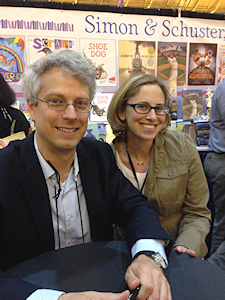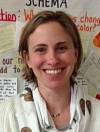 |
| Jenny Rich with Brian Floca at IRA 2014 |
Dear Colleagues,
This was my first year at the IRA conference. There are a lot of reasons why I didn't go before, but, mostly, there was this: it felt like a lot of money, and I didn't know anyone else who was going. Those things were still true this year (though—full disclosure—I had a friend/colleague/mentor there on the first day) but I decided to give it a try anyway.
Here is what I can tell you: Attending IRA 2014 was one of the best professional experiences of my life. I wish I had done it sooner. It might have changed the course of my career (really!) because my teaching and my network would have been so different.
You see, what I didn't know is that IRA is a celebration of the profession of teaching. Walking into the first opening session (to see Jeff Kinney speak, no less!) felt like walking into a concert, complete with flashing lights, fun music, and giant beach balls sailing around the room. I knew immediately that this was going to be like nothing I had experienced before.
Jeff Kinney set the tone for the conference, telling a room full of teachers that he believes "putting books in the hands of kids is a sacred act." This was after he explained that he walked away from being a cartoonist for a while—that he needed to put in his 10,000 hours to become an expert at writing and cartooning.
It was a moment of revelation: if even Jeff Kinney had to work this hard to be an expert, well,it's okay that writing doesn't come easily. Not to us, sitting in the audience, not to the kids we teach…. He was one of us! We were a room full of writers, united for a moment by the hard part.And Jeff Kinney made the hard part okay.
And that's when I realized that IRA was a place that would bring teachers together. It would make the hard parts of our days, our challenges, a source of camaraderie rather than isolation.
The conference continued this way, bringing teachers together in the most unexpected ways.We stood together in lines to get the most incredible swag. Leather tote bag from Scholastic? Got it! A tiny little speaker that plugs into my phone or tablet from Amplify? Yes, got that, too! How about the pounds and pounds of free books, many of which were signed by the authors? Got so many of those that I had to ship them home.
 (I mentioned that one reason I had waited to go to IRA was because I was concerned about cost. Well, I am fairly certain that if I were to add up the value of just the swag alone, the conference would pay or itself.)
(I mentioned that one reason I had waited to go to IRA was because I was concerned about cost. Well, I am fairly certain that if I were to add up the value of just the swag alone, the conference would pay or itself.)
The best part about the lines, though, was talking to the people I was waiting with—the coming together of teachers.
I got everything I needed from IRA, and found things that I didn't know I wanted. I met teachers from Kentucky and Kansas, from Minnesota and Canada. I met authors, both because I sought them out, and because they were everywhere, signing books and leading sessions. I listened to research from some of my personal heroes like P. David Pearson and Tim Rasinski, and then heard classroom applications of research from literacy rockstars, including (but not limited to) Chris Lehman and Donalyn Miller (though not together, though that would be REALLY cool.)
I walked away each night unable to fall asleep. At IRA I spent days surrounded by people who not only "got it," but who were inspiring. Dav Pilkey, the incomparable author of the Captain Underpants books (a favorite in my house) told a packed auditorium that "our job is to help kids discover the clues to the universe in what they choose to read." He also said, "There is a reading revolution going on under our noses, we just have to get out of the way. "Well, all right! That's the way to start a day, isn't it? As I walked out of his opening session, I overheard one teacher say to another, "I've always kept his books out of my classroom, but now I want to buy every single one!" That's the kind of impact IRA had.
 Every session, every moment spent in that convention center was one of inspiration, innovation, and collaboration. I have a notebook full of ideas waiting to be implemented, from how I communicate with students to ways in which I hope to get more involved with IRA going forward. My Personal Learning Network (PLN) on Twitter has expanded, which means that the learning that started at the conference will keep going for me. And, of course, I am already looking ahead to next year in St. Louis, a mantra at this year's conference.
Every session, every moment spent in that convention center was one of inspiration, innovation, and collaboration. I have a notebook full of ideas waiting to be implemented, from how I communicate with students to ways in which I hope to get more involved with IRA going forward. My Personal Learning Network (PLN) on Twitter has expanded, which means that the learning that started at the conference will keep going for me. And, of course, I am already looking ahead to next year in St. Louis, a mantra at this year's conference.
So, you see, going to the conference was a game changer for me. I am so grateful that I took this opportunity to attend this year, and—again—wish that I had done this sooner. For years I was an elementary school teacher, and, at times, I felt isolated in my practice (because, of course, this was before Meenoo Rami wrote her brilliant book Thrive:5 Ways to (Re)Invigorate Your Teaching, which I read in my hotel room in New Orleans). Now I teach preservice teachers, and want to make sure that they don't go through those periods of uncertainty in their own practice.
And so I write this letter to my current students who are about to enter the field, and for the teachers who, like me, are unsure if the IRA conference is really for them. It is.
You will leave enriched, connected, engaged, and eager to return home to your colleagues, students, and classroom.
You will remember why you became a teacher in the first place.
You will remember, as Jeff Kinney and so many others reminded us, that you are not alone in feeling challenged, and that the good stuff lies on the other side of those challenges.
I hope to see you next year, in St. Louis.
Jenny
 Jenny Rich is an adjunct instructor in the School of Education at Rider University in Lawrenceville, New Jersey, and a doctoral student at Rutgers University.You can find her on Twitter at @jdrich219, and will see her at IRA 2015 in St. Louis.
Jenny Rich is an adjunct instructor in the School of Education at Rider University in Lawrenceville, New Jersey, and a doctoral student at Rutgers University.You can find her on Twitter at @jdrich219, and will see her at IRA 2015 in St. Louis.